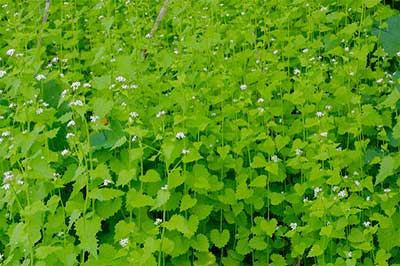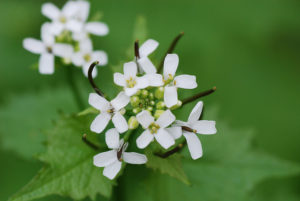Invasive Plant: Garlic Mustard
Why is garlic mustard a problem?
Garlic mustard grows well in cool temperatures, so it’s actively growing before many native plants wake up in spring. It also forms dense stands, allowing it to outcompete wildflowers and even tree seedlings. In fact, it can outcompete nearly any native plant in your woods.

What’s more, garlic mustard seeds can survive for up to seven years, so multiple years of control are needed to exhaust the “bank” of seeds in the soil.
How do I recognize it?
Garlic mustard is a non-woody plant that grows approximately two- to four-feet tall. It’s a biennial, meaning it has a two-year life cycle.
In the first year, garlic mustard develops a basal rosette of leaves – i.e., leaves clustered on the ground. In the second year, a flowering stalk grows out of the basal rosette.
The flowers are small – about ¼-inch in diameter – with four white petals. By May or June, the petals have fallen off and the seed pods are developing and getting longer. The pods usually mature by July.
After seed production, the plant has completed its life cycle and dies. The dead stems remain standing for the rest of the year, and continue to shed seeds. All green parts of the plant have a distinctive garlic odor when crushed.

Where does it grow?
Garlic mustard grows best in slight to heavy shade. It will grow on almost any soil type, but spreads most quickly in moist, rich soils.
How does it spread?
The seeds are small and attach easily to any wet or muddy surface, such as people’s boots, the hooves of deer and horses, animal fur, mower decks, logging equipment, and tires. This is why new plant populations usually start along a trail, roadside, deer path, or logging road. It’s also why you should get in the habit of cleaning your boots, pets, and equipment before entering and leaving the woods.
How do I control it?
Small garlic mustard infestations can be controlled with hand-pulling. Be sure to pull out the entire root because roots left in the ground can re-sprout and produce seeds. Plants with mature seed pods should be bagged and removed completely from the woods.
Large infestations are best controlled by spraying with the herbicide, glyphosate (the active ingredient in Roundup and other products). Mix glyphosate with water to make a solution of 1.5 to 2% active ingredient. Apply herbicide in early spring or late fall when native plants aren’t actively growing and won’t be harmed.
